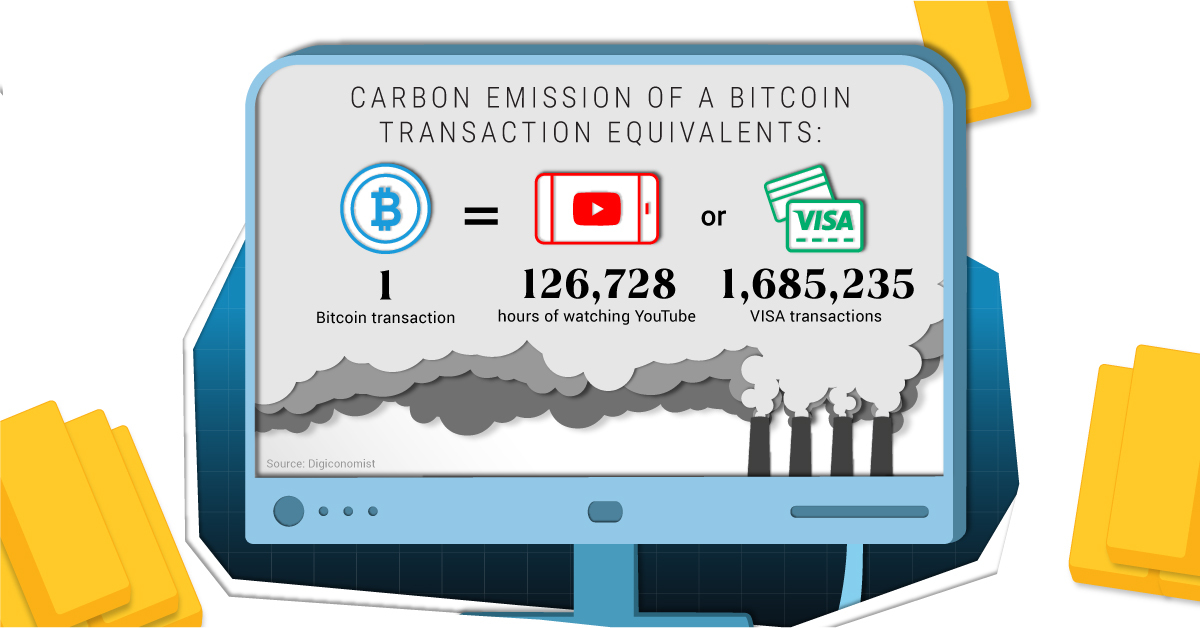Comparing the Carbon Footprint of Gold and Bitcoin
The following content is sponsored by Prospector Portal.

The Carbon Footprint of Gold and Bitcoin
The year 2020 shook economies and financial markets around the world, creating uncertainty and volatility. This led investors to seek out alternative assets such as gold or bitcoin to weather the storm. Bitcoin stole the headlines from gold and attracted new investors in record numbers.
While this digital asset may exist in the electronic cloud, its increased adoption and energy use have significant environmental impacts. This infographic sponsored by Prospector Portal takes a look at the carbon footprint of bitcoin and gold.
Price Performance Increases Adoption
In early May, the value of the bitcoin market was $1.05 trillion, only 9% of the gold market’s $11.67 trillion value. Despite this, bitcoin performance is rising to challenge gold as an alternative asset in volatile markets.
In 2020, gold delivered a strong return with 25.12% over the year, and reached a historic high of $2,067 per ounce in August. However, the value of bitcoin rose 536.7% between May 2020 and May 2021, outperforming pretty much every asset possible over that timeframe.
According to Reuters, investors poured $5.6 billion into cryptocurrency funds and products in 2020, up more than 600% from 2019. This increased activity led to increased trading in the Bitcoin network, needing more energy.
Each $1 billion in inflows into Bitcoin uses the same amount of energy as 1.2 million cars”
– Bank of America
The Bitcoin network uses massive amounts of computational power to validate transactions as people trade bitcoin. For example, if you did some rough math, it would take 1,312 lightning strikes or you would have to drive 1,240,476 miles to produce the energy to mine one bitcoin. This amount of energy translates into serious emissions.
Comparing Carbon Footprints
Digital assets are deceiving in that they appear to generate out of thin air, but there is real power usage behind mining bitcoin. According to independent researchers Max Krause and Thabet Tolaymat, it takes 17 megajoules (MJ) of computer power to generate $1 of bitcoin and only 5MJ of energy to produce $1 of gold.
In fact, bitcoin mining is nearly 15X more carbon intensive than mining an equivalent amount of gold (in dollar terms). The carbon footprint of a single mined bitcoin (including fees) amounts to 191 tonnes of carbon dioxide while to mine the equivalent value in gold, it would only take 13 tonnes of carbon dioxide.
Hard Asset or Digital Drain?
The debate around the value and use of bitcoin and gold takes center stage while its environmental impacts lurk in the shadows. This is not unique to bitcoin, as obviously gold has its own footprint on the environment. That said, both of these assets are mined out of sight and out of mind for end consumers.
However, gold has always been gold, even before the advent of electrification. How much is a bitcoin worth when the lights go out?
-

 Sponsored3 years ago
Sponsored3 years agoMore Than Precious: Silver’s Role in the New Energy Era (Part 3 of 3)
Long known as a precious metal, silver in solar and EV technologies will redefine its role and importance to a greener economy.
-

 Sponsored7 years ago
Sponsored7 years agoThe History and Evolution of the Video Games Market
Everything from Pong to the rise of mobile gaming and AR/VR. Learn about the $100 billion video games market in this giant infographic.
-

 Sponsored8 years ago
Sponsored8 years agoThe Extraordinary Raw Materials in an iPhone 6s
Over 700 million iPhones have now been sold, but the iPhone would not exist if it were not for the raw materials that make the technology...
-

 Sponsored8 years ago
Sponsored8 years agoThe Industrial Internet, and How It’s Revolutionizing Mining
The convergence of the global industrial sector with big data and the internet of things, or the Industrial Internet, will revolutionize how mining works.


